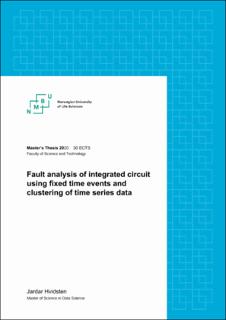| dc.description.abstract | The evolution of society is strongly dependent on technology development. Hardware (HW) development is crucial, however software (SW) development has become increasingly important in recent years due to the automation and digitalization focus in industries such as the automobile industry, the airline industry and in the oil and gas industry. Control systems are responsible for the control of modern petrol and electrical engines, airplane systems, power plants etc. Such control systems need reliable HW. In this thesis we will apply statistics and clustering algorithms to investigate a fault that is present in a microcontroller on an electronic card. The electronic card is a major component in a control system. Preliminary investigations indicate that the fault is temperature dependent. In addition, the microcontroller producer and the company owning the electronic card design does not agree whether the electronic card or the microcontroller is to blame.
To gain more knowledge about the behaviour of the fault and possibly settle the disagreement, four research questions will be investigated in this thesis.
1. Is there a temperature dependent start-up fault in some of the microcontrollers?
2. Do several of the microcontrollers on the same board fail?
3. Does the temperature range, the span of the range and severity of the fault vary from microcontroller to microcontroller?
4. Is it possible to predict if the microcontrollers are prone to the start-up fault by measuring the start-up voltage profile and the reset circuit signal (a signal forcing a reset of a component or preventing the component from starting up)?
The investigations done concludes that the fault is temperature dependent. This is confirmed by performing a statistical test on the fault distribution (by using the fixedTimeEvents R library). Only one of the five microcontrollers failed on the three cards with the fault. The microcontroller location on the card was different for each case. The temperature range and the span of the range is different for each case. Each card has a consistent fault signature through several tests.
The 2.5V profile and reset signal measurements show promising results. With the current dataset, the three cards that fail cluster together when performing K-Means with four cluster centres on the 2.5V and the reset signal. However, the dataset is too limited to conclude that they have a significant impact on the fault. A test sequence where components are swapped is suggested to observe the effects of changing the 2.5V profile and the reset signal on the fault behaviour. Since the fault is only present in one of five microcontrollers on a card, and they share the 2.5V and the reset signal, the fault is believed to be a result of coinciding marginalities. It is unlikely that we will be able to predict which units will fail. However, the results indicate that we can identify units that have external factors which must be present for the fault to occur. | en_US |

